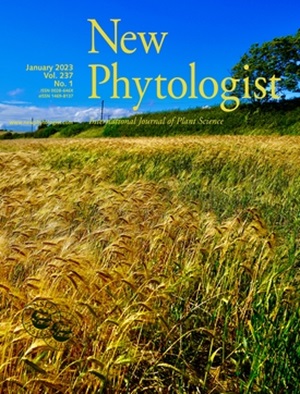MYC2和MYC3协调髓木质化,以保护烟草茎免受茎蛀象鼻虫的侵害。
IF 8.1
1区 生物学
Q1 PLANT SCIENCES
引用次数: 0
摘要
木质素是一种关键的结构聚合物,也可以作为对抗生物应激的有效防御。草食诱导的茉莉酸依赖的木化作用在防御茎螟虫毛线虫中起着至关重要的作用。然而,草食诱导木质素化的调控机制在很大程度上仍然未知。我们证明NaMYC2和NaMYC3协调髓特异性木质化,以响应T. mucorea的攻击。RNA-seq分析显示,单核脂素生物合成基因和聚合相关基因在Namyc2/3双突变体中无法被粘膜分枝杆菌攻击诱导。在受攻击髓内的namyc2 /3依赖性基因中,我们发现了NaTHT1,它负责合成非规范单分子N-FT。利用nath1突变体,我们进一步证明N-FT在干细胞防御中起关键作用。此外,我们在髓中鉴定了NaNEC1a和NaNEC1c, namyc2 /3依赖性超氧化物歧化酶。Nanec1a/1c双突变体表现出木质化减少和幼虫性能增强,支持超氧化物代谢和诱导木质化之间的直接联系。我们的研究结果揭示了namyc2 /3介导的髓内单脂生物合成、木质素聚合和非规范单脂生物合成的调控网络,从而增强了茎对粘菌的防御。本文章由计算机程序翻译,如有差异,请以英文原文为准。
MYC2 and MYC3 orchestrate pith lignification to defend Nicotiana attenuata stems against a stem-boring weevil.
Lignin is a key structural polymer that also serves as a potent defense against biotic stress. Herbivore-induced, jasmonate-dependent pith lignification in Nicotiana attenuata plays a crucial role in defense against the stem-borer Trichobaris mucorea. However, the regulatory mechanisms underlying herbivore-induced lignification remain largely unknown. We demonstrate that NaMYC2 and NaMYC3 orchestrate pith-specific lignification in response to T. mucorea attack. RNA-seq analysis reveals that monolignol biosynthetic genes and polymerization-associated genes fail to be induced in Namyc2/3 double mutants upon T. mucorea attack. Among NaMYC2/3-dependent genes in the attacked pith, we identify NaTHT1, responsible for synthesizing the noncanonical monolignol N-FT. Using Natht1 mutants, we further show that N-FT plays a key role in stem defense. Additionally, we identify NaNEC1a and NaNEC1c, NaMYC2/3-dependent superoxide dismutases in the pith. Nanec1a/1c double mutants exhibit reduced lignification and enhanced larval performance, supporting a direct link between superoxide metabolism and induced lignification. Our findings reveal a NaMYC2/3-mediated regulatory network in the pith that integrates monolignol biosynthesis, lignin polymerization, and noncanonical monolignol biosynthesis, thereby enhancing stem defense against T. mucorea.
求助全文
通过发布文献求助,成功后即可免费获取论文全文。
去求助
来源期刊

New Phytologist
生物-植物科学
自引率
5.30%
发文量
728
期刊介绍:
New Phytologist is an international electronic journal published 24 times a year. It is owned by the New Phytologist Foundation, a non-profit-making charitable organization dedicated to promoting plant science. The journal publishes excellent, novel, rigorous, and timely research and scholarship in plant science and its applications. The articles cover topics in five sections: Physiology & Development, Environment, Interaction, Evolution, and Transformative Plant Biotechnology. These sections encompass intracellular processes, global environmental change, and encourage cross-disciplinary approaches. The journal recognizes the use of techniques from molecular and cell biology, functional genomics, modeling, and system-based approaches in plant science. Abstracting and Indexing Information for New Phytologist includes Academic Search, AgBiotech News & Information, Agroforestry Abstracts, Biochemistry & Biophysics Citation Index, Botanical Pesticides, CAB Abstracts®, Environment Index, Global Health, and Plant Breeding Abstracts, and others.
 求助内容:
求助内容: 应助结果提醒方式:
应助结果提醒方式:


